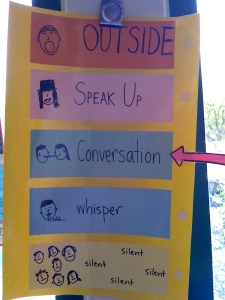
- You’ll find examples of little visuals like this to use in your classroom to build community and independence.
- Visual created by Natalie Dean,
- 3rd grade teacher, Brookline, MA
When we begin to work closely with at least one other adult in the room, we have to communicate and agree on just about every little detail of our day. All of a sudden we have to think about brand new questions like: Who is going to be in charge of which lessons? What should transitions look like? Do we both have to take conference notes? Should we use Station Teaching? What IS Station Teaching? Where did that kid go?
As long-time co-teachers we have developed lots of theoretical ideas about working together to create successful inclusive classrooms, which you can read on our main page. But we also want to provide the much-needed nitty-gritty tips on how to make your classroom function effectively with two adults, service providers coming and going, and about a thousand different kids’ needs.
Our advice is spend time at the beginning (or now, right after winter break) to answer these questions by putting in place a few simple systems to foster teacher cooperation and student independence in your classroom. Enter, the newest section of our blog, the Collaboration Toolbox. Here we will provide real-world examples (Pictures! Printables!) of effective and efficient ways to make your classroom flow smoothly, including:
- detailed explanations of several co-teaching models
- samples of great visual supports from real classrooms
- handy co-planning tools
- tried-and-true adaptive materials
- other goodies
The honest truth is that it takes more legwork and a bit more laminating to set up a successfully co-taught classroom, but in the end, we think it’s worth it.
“I am not afraid of storms for I am learning how to sail my own ship.”
-Louisa May Alcott
Make that a “we,” Louisa, and we’re on board. You can start today by checking out the Collaboration Toolbox!
